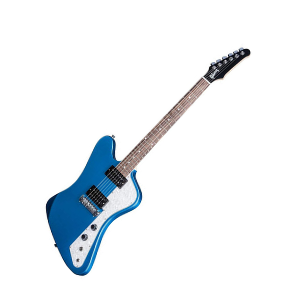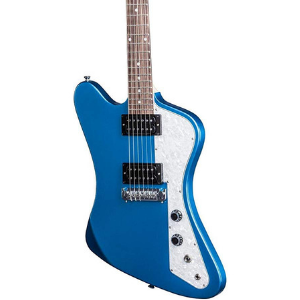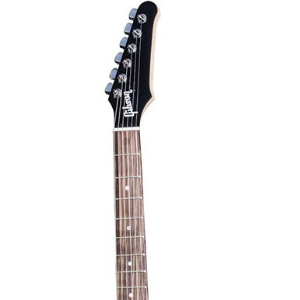- Home
- Instruments
- Gear
- Recording
- Lessons
- Reviews
- Blog


| Body And Neck: |  |
| Electronics: |  |
| Hardware: |  |
| Sound: |  |
| Value: |  |
Along with Fender, Gibson is possibly the most iconic brand in the history of the electric guitar. With over 100 years of experience manufacturing guitars, it's hard to beat the brand's knowledge. Along the way, Gibson has created some legendary guitar models, like the Les Paul and the ES-335.
Along with those historic body shapes, the Firebird has survived in production for over 50 years. While Gibson has offered Firebirds with plenty of unique designs (and at many different price points) before, the Firebird Zero was a new step upon its release in 2017.
The Firebird Zero promised American-made craftsmanship and Gibson quality at a sub-$500 price — it's no wonder the model generated so much interest in the guitar community! And while it's not currently in production, you can still find used Firebird Zero guitars floating around all different corners of the market. However, is it worth spending your money? To answer the question, let's take a look at the specifics of this model and see how it stacks up.
 Body and Neck
Body and NeckOpinions on the Firebird Zero's distinctive body shape range from “at least it's unique!” to “it looks like a piece of chewed gum.” Taste is obviously subjective, but off the bat, this looks like an odd interpretation of a non-reverse style Firebird design. It's surprising that Gibson didn't take the far more popular “reverse Firebird” body shape for this model.
The body itself is actually made from solid C-grade poplar, with a one-piece set maple neck and rosewood fretboard. That set neck is a nice touch considering the price range, and the maple neck is a distinctive offering for Gibson — the company uses mahogany necks on many of its other guitars. The neck itself plays very smoothly with a comfy SlimTaper profile and satin finish that's good all around.
Unfortunately, the poplar wood makes the body incredibly light and throws the balance of the guitar out of wack. Neck dive is common here; it may take some effort to keep the neck up whether you play sitting or standing.

The Firebird Zero comes outfitted with a pair of Gibson DS-C humbuckers. While they're advertised as “punchy,” that description doesn't do these things justice: they're humbuckers in name only and sound far more like single-coils in reality. It's hard to get much bass or warmth out of these pickups, and at points, they're so bright they could outshine a Stratocaster.
Now, that's not to say that they're unusable — while many players dislike them, others enjoy the variety and manipulate them to produce great tones. However, if you're looking for these to sound like BurstBuckers or P.A.F. pickups, you'll be sorely disappointed.
Beyond the pickups, the guitar features a bare-bones control setup. There's just a single volume and tone knob, along with a three-way switch positioned by the input jack at the base of the guitar. These pots are made in Korea rather than the United States, but they work smoothly enough and don't cause any issues.
This is really where the budget price of the guitar begins to show through. Gibson outfitted this model with a one-piece wraparound bridge, in contrast to their standard Tune-O-Matic bridge and stopbar tailpiece setup. In and of itself, this might not be a problem, except for the fact that the bridge tilts with strings put on. While string action is theoretically adjustable, the tilt means that even at their lowest, the strings are still somewhat high off of the fretboard. It's a serious design flaw that shouldn't have made it into the final product.
The rest of the hardware is passable, though quality control remains an issue in some parts. Frets aren't always level, with some guitars experiencing fret spout as well (this is where the frets extend past the edge of the neck and need to be filed down). The nut is made of tektoid, which is a little better than plastic but works fine for the price. Some players also report stability issues with the stock set of Gibson tuners. The pegs may come out of the factory loose; a quick tightening on the screws can do wonders to improve them.
Finally, the aesthetic work is rather inconsistent. While this guitar offers a nitrocellulose lacquer finish — an almost unheard-of feature for a guitar in this price point — it's dull and not always evenly applied. Under certain lighting, it can appear glossy and matte at the same time! A few players also report visible paint lines on their instruments. In a similar vein, the Gibson logo isn't actually located on the headstock, but on the truss rod. It's a minor detail, but it looks a bit sloppy and out of place when compared to classic Firebird models.
As we mentioned above, these pickups don't sound anything like traditional Gibson humbuckers. Depending on your perspective, they could be either a great set of single-coil sound-alikes or a thin and tinny pair of humbuckers. While the difference in opinion largely comes down to personal taste, there are some concrete things about the sound here that we can evaluate to help you determine whether or not to purchase this guitar.
First, you should know that you won't be able to replicate the tones of many classic Gibson instruments with a Firebird Zero — indeed, even vintage Firebird tones may be out of reach. The distorted tones of the Firebird Zero sound nice and throaty, but they're more single-coil saturation than humbucker growl as well. Don't expect to play this guitar for much metal or hard rock. You'll find far better models in the Epiphone catalog for playing high-gain distortion or classic rock crunch.
The bright and cutting sounds that this guitar does produce make it a better fit for funk, pop, and indie. It's certainly hot and in-your-face, with plenty of punch and bite. The real question is whether it's better suited for these purposes than a Stratocaster or Telecaster (to name a couple) in the same price range. On those counts, it's hard to argue for the Firebird Zero. It's an interesting instrument, to be sure, but for the $499 retail price, you can find Squier or Fender models that offer purer and clearer single-coil tones without the sharp, ice-picky character the Firebird Zero sometimes has.
The Gibson Firebird Zero has some interesting features, but ultimately, it doesn't really compare to the other guitars in this price range. It seems that Gibson figured the American craftsmanship and Gibson brand would compensate for the other flaws with this design, but ultimately, they're too glaring to overlook.
That's not to say that the Firebird Zero is a total junker — it offers good approximations of a single-coil sound, has a nice trebly saturation, and features a great-playing maple neck. If you have modding experience and want to mess around, this could be a good platform. However, as sold, it doesn't feel like a good fit for any category of guitar players. With other options for $500 that are far more thoughtful and focused, the Firebird Zero struggles to compete.

Reader Interactions